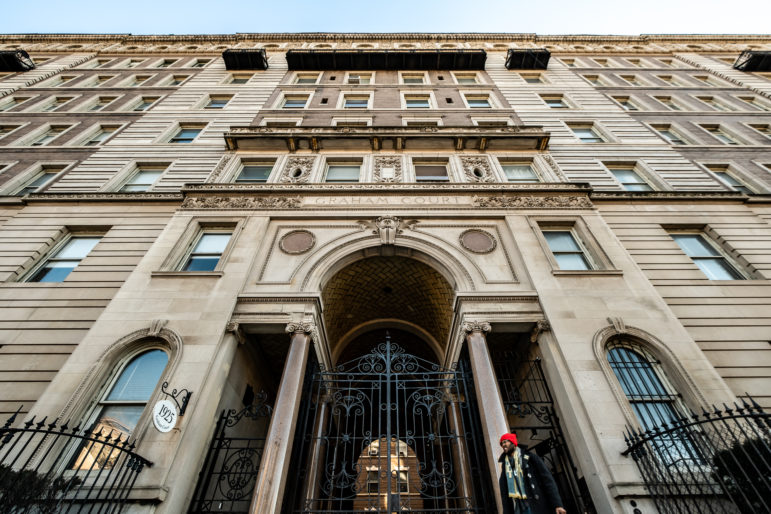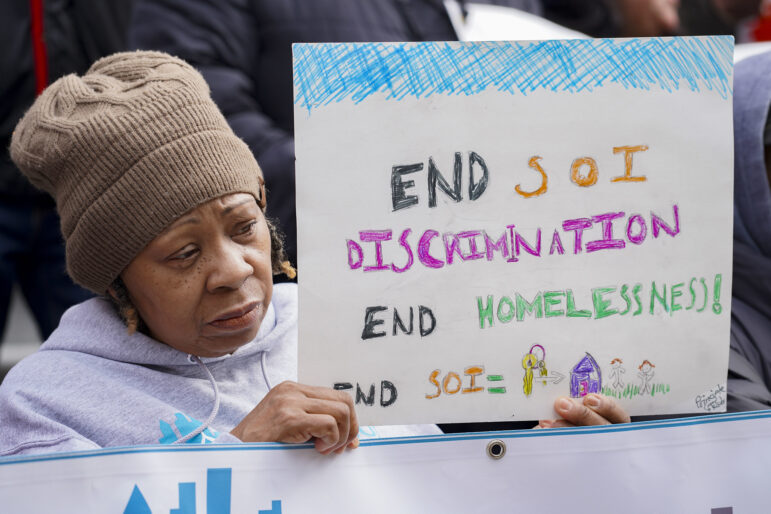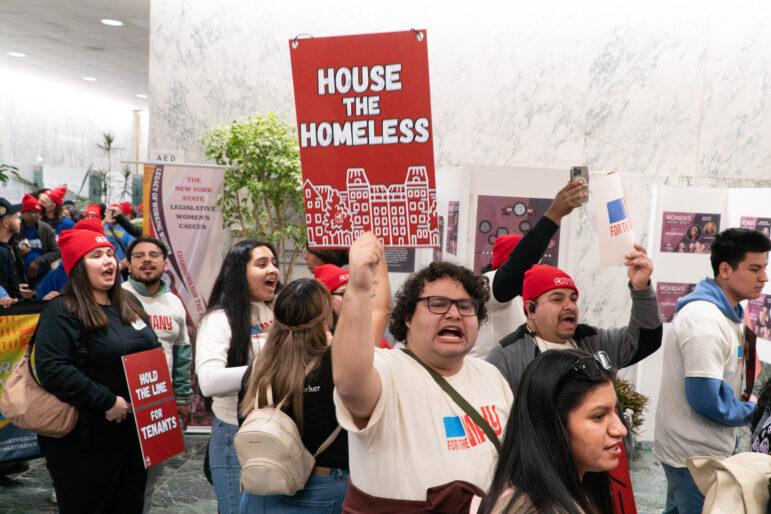
Adi Talwar
Graham Court on the North East corner of 116th Street and Adam Clayton Powell Jr Boulevard. It played a fictional role in ‘New Jack City’ and has had a real-life part in wealth’s transformation of Harlem.
Watch your back and your wallet. It’s a scary city out there.
Muggers and rapists are forever lurking along the Upper West Side, sociopathic sex workers are murdering cops in the South Bronx and drug dealers are turning Harlem apartment complexes into crack emporiums— at least in the movies.
For decades, popular Big Apple-based films like Death Wish,New Jack City, Bonfire of the Vanitiesand Fort Apache, the Bronxhave depicted a bleak and deadly city, playing up narratives of crime and despair that continue to inform perceptions for outsiders and New Yorkers alike.
“We give tours and sometimes people will say, ‘Well is this really Harlem?’ because they expect crime. They ask about New Jack City,” said Yuien Chin, executive director for Harlem One Stop, an organization that promotes arts, culture and businesses in Northern Manhattan. Chin has lived in Hamilton Heights for 30 years. “And the thing is that contemporary movies now being shot are period-based and still fall back on the negative narrative.”
That negative narrative takes place within a phony context of intractable income inequality. In this fiction, poor New Yorkers of color are nasty, scheming and savage — only aggressive cops and brave vigilantes can beat them back.
New York City in the 1970s and 1980s did indeed have high rates of crime, unemployment and poverty — but not because of some innate moral failing of its low-income residents, as some films seem to suggest. New Yorkers, especially people of color, were subjected to systematic disinvestment at all levels of government, disastrous infrastructure decisions that scarred neighborhoods, the outbreak of HIV and a crack epidemic.
Yet, says award-winning investigative journalist Tom Robbins, “a lot of us managed to get to work, raise kids and have birthday parties in Central Park or Prospect Park. It’s not that we didn’t have an environment with crime, but that image is willfully created.”
The negative narratives in film remain handy tools to justify over-policing and today’s disruptive private development, Robbins says.
“Stuff is still exaggerated for the purpose of a political argument,” he says, adding that proponents of gentrification or aggressive policing maintain “that if you don’t like how it is now, then we’ll go back to being Fear City.”
Fear City in film
Thousands of tourists arriving at Kennedy and LaGuardia Airports in 1975 received a freaky greeting when they stepped off the plane: a pamphlet with a hooded skull on the cover welcoming them to “Fear City.”
That was a characterization of the city on pamphlets handed out by police and firefighters’ unionsin an effort to counter planned law enforcement layoffs. “Avoid public transportation,” reads one of the pamphlet tips. “You should never ride the subway for any reason whatsoever.”
The notion of Fear City was likely a familiar one to any theatergoers who watched the 1974 hit Death Wish,in which a “bleeding heart liberal”-turned-vigilante named Paul Kersey fights crime by murdering muggers. Kersey, played by Charles Bronson, begins carrying a gun after his wife is killed and his daughter raped inside their Upper West Side condo.
Kersey quickly gets tough on crime.
He shoots a desperate mugger in the stomach and lets him bleed out on the path next to Jacqueline Kennedy Onassis Reservoir. He shoots a mugger in the stomach and lets him bleed out in the Times Square subway station. He shoots a mugger in the stomach and lets him bleed out on a subway floor.
More than four decades later, that sort of dystopian urban fantasy continues to tantalize. It’s the kind of worldview that compels Sean Hannity to strap up and gun-toting tourists to fight for a concealed carry reciprocity billso they can pack their pistols on the subway.
That image of Fear City also persists today as the threat of what the city could become again if it gets too soft on crime.
It was the notion cited by proponents of stop and frisk, like the Daily News editorial board, which condemned Federal Court Judge Shira Scheindlin’s 2013 ruling that the practice was unconstitutional.
“Make no mistake — Scheindlin has put New York directly in harm’s way with a ruling that threatens to push the city back toward the ravages of lawlessness and bloodshed,” the News wrote in a 2013 editorial. Three years later, the editorial board acknowledged that they were wrong, writing that “New York has come through to a brighter day.”
A Symbol of NYC in two eras
The Rotten Tomatoes Critics’ Consensus considers Death Wishas “undeniably exploitation fare — and also undeniably effective.” It’s certainly not the only film that paints a bleak portrait of urban decay and brutal law enforcement.
“Crime takes people out of their real life, but people associate that depiction with the place,” says Harlem Historical Society Director Jacob Morris. “You can enjoy a movie and then question how realistic it is and the role of films and different directors in the depiction of stereotypes.”
For communities of color, the stereotypes include criminality and on screen their crimes deserve a disproportionate response from law enforcement.
The Best and Worst Movies About New York City
In the 1991 film New Jack City, Detective Scotty Appleton, played by Ice T, sets up a transaction to entrap a low-level stick up artist named Pookie, played by Chris Rock. Pookie promptly swipes a bag stuffed with cash from Appleton and Appleton chases him through Harlem before finally shooting Pookie in the ankle in the middle of a crowded playground.
Though New Jack City revolves around crime and violence via the rise of Harlem drug kingpin Nino Brown, the movie, more than many others that depict New York City strife, attempts to contextualize the urban crises.
“You gotta rob to get rich in the Reagan era,” Nino says. “More poor and disenfranchised folks than this place has ever seen.”
Nino, played by Wesley Snipes, gets rich by operating an efficient crackhouse out of an apartment complex called the Carter, which is actually Graham Court, a 100-unit building located along 7th Avenue at 116th Street, within Manhattan’s Community District 10.
Thirty years after the Reagan Era, a laissez faire approach to real estate development has contributed to gentrification and vast income inequality in the neighborhood.
Here again, Graham Court serves as a symbol.
A one-bedroom apartment in the building now rents for $2,600 a month— even though 21.1 percent of Community District 10 residents live below the city’s poverty threshold and 40.1 percent spend more than 35 percent of their income on rent, according to the Planning Department’s 2016 Community Profile.
Income equality is no longer defined by neighborhood boundaries, like East 96th Street or West 110th Street. It is evident block to block, building to building.
But conventional wisdom often argues that, were New York to restrain private development, it would risk plunging Graham Court and the rest of the city back into the days ofNew Jack City.
Countering the single story
For years, residents have advocated for more nuanced representations of their communities. At times, New Yorkers have taken to the streets to protest films that rely on negative stereotypes, as in the case of Fort Apache, the Bronx.
The 1981 police drama stars Paul Newman as Murphy, a veteran cop in the 41st Precinct, which is nicknamed “Fort Apache” because cops consider it a safe “fort in hostile territory.”
From the start of filming, the movie faced criticism from local community members who said the filmmakers exploited a bleak vision of the South Bronx and its poor residents with little context as to the systemic causes of poverty.
The film begins with a sex worker named Charlotte, played by Pam Grier, shooting and killing two rookie cops sitting in their squad car. Other residents scurry out of alleys to rob the dead officers. The random act of violence and ensuing disregard along a desolate strip of the South Bronx set the tone and demonstrate why the cops needed to start cracking down in the neighborhood “war zone.”
A 1981 review in The New York Times described the film’s depiction as “an urban nightmare, a contemporary American vision of World War II Hamburg (or Dresden or Manila or Hiroshima), destroyed not by saturation bombing, artillery warfare or the A-bomb but by decades of what is euphemistically referred to as urban decay, civic neglect and shifting population patterns.”
Community activists known as the Committee Against Fort Apache rallied to oppose that portrayal.
“They were in our neighborhood. This was our territory, and they were an invading force,” journalist Gerson Borrero, one of the protestors, told NPR in 2011. “They were here to really do us harm. Not physical. But [to] film something that was not totally true.”
The activists earned one concession from the filmmakers: an on-screen disclaimer before the film begins.
“The picture you are about to see is a portrayal of the lives of two policemen working out of a precinct in the South Bronx, N.Y.,” the text notes. “Because the story involves police work, it does not deal with the law-abiding members of the community, nor does it dramatize the efforts of the individuals who are struggling to turn the Bronx around.”
Ultimately, even the film’s lone, relatively well developed South Bronx resident fulfills a neighborhood stereotype. Murphy’s girlfriend, a Latina nurse named Isabella, dies of a heroin overdose.
“A lot of us thought it was outrageous to make movies that only highlight everything lousy in the Bronx,” says Robbins, who participated in the protests alongside many people who worked to improve neighborhood conditions in the absence of city or private investment.
Bonfire of the stereotypes
The simplistic, detrimental narrative persisted nine years later in Bonfire of the Vanities,a 1990 satire about the pathetic egos and racial biases in New York City based on a novel by Tom Wolfe.
In the film, wealthy bond salesman Sherman McCoy, played by Tom Hanks, misses the Manhattan exit on the Triborough Bridge while driving with his mistress Maria and has to turn around in Mott Haven. For the first time ever, Sherman finds himself on a crowded and chaotic Bruckner Boulevard, where a black man pushes a woman onto the hood of Sherman’s car and another black man, perhaps with mental illness, appears at the passenger-side window.
Sherman drives by flaming cars as he desperately seeks a highway on-ramp, but he must stop and exit the vehicle to remove a tire from the middle of the road.
Once outside the car, two men approach Sherman, who fears for his safety and his property. Maria, still inside the vehicle, hops into the driver’s seat, hits the gas pedal and plows into one of the men, who later falls into a coma.
“We were in the jungle and we were attacked,” Maria says to justify the hit and run.
That caricature of the South Bronx, useful for illustrating an Upper East Side elitist’s fear of the low-income people on the other side of the Harlem River, continues to inform perceptions among out-of-towners and New Yorkers alike, says Bowdoin College Professor Brian Purnell, a member of the Fordham University Bronx African American History Project(BAAHP), which compiles stories from black Bronx residents.
“People who don’t know New York, don’t know cities in general or have particular ideas of poor or working class sections — they’re always going to talk about what’s bad and what’s dangerous,” Purnell says. (See countless “Is New York City safe?” TripAdvisor message boards)
The experiences of the BAAHP interview subjects contrast the single story depicted in many films, Purnell says.
“If you have this stereotypical depiction of a completely desolate and abandoned and chaotic place there can be no real understanding that there are people there who are trying to live and living in all kinds of ways,” Purnell says. “The conventional wisdom that filters into politics, policing and pop culture is that the people there don’t care [and] it’s not true.”
Purnell pointed to the example of Genevieve Brown, a Bronx resident he interviewed for the BAAHP. Brown united tenant associations and community organizations in the Mid-Bronx Desperados to contend with absentee landlords and deteriorating building and block conditions.
Such stories are vital for countering stereotypes, but are easy to ignore, writes Katherine Simpson in the scholarly article “Media Images of the Urban Landscape: the South Bronx in Film.”
“People were quite likely to remember the dark streets full of pimps, hookers, burnt-out cars, and blazing fires from the films Fort Apache: the Bronx or Bonfire of the Vanities,or Howard Cosell in 1977 announcing the burning of the Bronx while images of a flaming building appeared on the television screen,” Simpson writes. “It was less probable that many people would remember a newspaper article discussing economic revitalization or construction of new housing.”
Media depictions of the South Bronx have become more nuanced, Simpson concludes. she focuses on Finding Forrester, a 2000 film about a gifted black writer and athlete played by Rob Brown who connects with a renowned author-turned-hermit played by Sean Connery.
Other professors,commentatorsand bloggers, however, regard Forresteras another example of the White Savior subgenre.
The 1983 South Bronx film Wild Stylewas regarded by Complexas the “best film ever made about hip-hop [and] also the first.” More recently, the Netflix series The Get Downprovides a more comprehensive depiction of the South Bronx in the late 1970s while featuring a cast comprised almost entirely of people of color.
But an untold number of “Best New York City Films” lists are stuffed with movies depicting white characters in love, white characters in battle, white characters involved in crime, white characters living completely mundane lives. That is rarely the case for New Yorkers of color.
Why movies matter
The lack of easily identifiable films or television shows about nuanced life in the South Bronx seems to point to another one of Simpson’s arguments. Blockbuster films have a “rippling effect,” influencing everyday citizens as well as lawmakers, she says.
“Once the media tarnishes the image of the city or a neighborhood, it is difficult to reverse public perception,” Simpson says. “An irrational fear of threat may replace an analysis of real crime figures, resulting in a call for more security when it may be unnecessary.”
More than 19 years have passed since flash-in-the-pan Atlanta Braves closer John Rocker describedhis racist, xenophobic, anti-gayperception of New York City residents and neighborhoods.
“Imagine having to take the 7 train to the ballpark, looking like you’re [riding through] Beirut next to some kid with purple hair, next to some queer with AIDS, right next to some dude who just got out of jail for the fourth time, right next to some 20-year-old mom with four kids. It’s depressing,” Rockersaid, before describing his hatred for immigrants.
It was frank. It was hateful. It was also exactly the kind of place depicted in decades of New York City films.
Unlike Rocker’s straight-forward rant, stereotypes about New Yorkers of color are more often shrouded or implied by people with a platform — like outgoing U.S. Rep. John Faso scorning challenger Antonio Delgado’s “New York City values” during his losing bid for re-election.
There are, of course, other elements of the hangover from “the bad old days” besides film. One such legacy enabled Amazon to sidestep the Uniform Land Use Review Process its sweetheart deal to settle in Queens because the state canshepherd the project underthe Urban Development Corporation Act, a 1968 measure to rehab “a slum, blighted, deteriorated or deteriorating area” — a fascinating classification of Long Island City, the country’s fastest growing neighborhood in terms of new skyscraper condominium construction.
That term “blighted” is itself as loaded and antiquated as some of these films, used as both a legal and emotional justification for clearing and redeveloping the neighborhoods depicted in the fear city films.
And of course, thanks to services like Amazon’s Prime streaming (as well as Google’s YouTube and other on-demand services), the Fear City films that inform implicit and explicit prejudice of people and stereotypes about communities are available, every day.
City Limits’ reporting on the intersection of art and policy is supported by the Laurie M. Tisch Illumination Fund. City Limits is solely responsible for all content.










3 thoughts on “‘Fear City’ on the Big Screen: The Classic Films that Miscast NYC”
Most people realize that movies are just movies. Many parts of NYC were hell-holes in the 1970s and 80s and some films of the time reflected that truth. The NYC of ‘Taxi Driver’ was pretty truthful and it’s a serious film. But the movies in the article are had to take seriously.
Taxi Driver – https://www.imdb.com/title/tt0075314/reference
The writer is so right! I lived through this time in the 70’s when my suburban friends thought I was taking my life in my hands every time I ventured into NYC! What a shame and what an unreal, simplistic, and racist portrait of life in the city!
Pingback: ‘Fear City’ on the Big Screen: The Classic Films that Miscast NYC